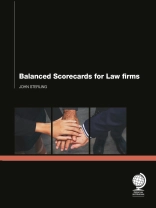In an era in which law firm performance is increasingly public – and a determining factor for where the best lawyers decide to practise – it seems clear that firm management would want to adopt tools that are proven to improve performance. An increasing number of firms are now adopting this long established tool and there is growing evidence that firms which employ balanced scorecards to drive strategy implementation have significantly improved shareholder returns. Balanced Scorecards for Law Firms report provides a vital introduction for firms wanting to know more about how the balanced scorecard can improve their own firm’s performance. The report and the tools explained within it reach well beyond revenue per lawyer and profit per equity partner to identify meaningful measures and actions related to the development of quality people, highly satisfied clientele, and superior business practices and processes. Specifically, the report will give you a clear understanding of: The balanced scorecard concept and tool, its practical application and the results you can achieve from its adoption; How to apply the concept in a law firm environment – the central opportunities and challenges the tool presents for law firm management; and Each of the major elements of a balanced scorecard – with an emphasis on their meaning in a law firm environment: Financial measures; Client measures; Learning and growth; and Business processes. Balanced Scorecards for Law Firms provides you with pragmatic advice, real world case studies and invaluable expertise to help you begin utilising a tool that can dramatically improve focus, accountability and execution of strategy. Begin outperforming your competitors in an increasingly difficult and aggressive market place.
Tabella dei contenuti
Part One: Theory and practice of implementing balanced scorecards in law firms Chapter 1: The balanced scorecard – an overview of Kaplan and Norton’s system; The balanced scorecard in its most basic form; The balanced scorecard as a management tool Rationale and arguments for the balanced scorecard; Looking forward towards law firm adoption. Chapter 2: Applying the balanced scorecard in a law firm environment – opportunities and challenges; Nature of the opportunity; Linkages to profit per partner; Effective implementation; Practice group performance; Challenges to adopting balanced scorecards in law firms. Chapter 3: Financial measures – applying the financial element; High-level objectives; Profit drivers; The constricting denominator – equity partnership; Conclusions. Chapter 4: Client relationship measures – applying the client satisfaction element; High-level objectives; Strategies and action plans driving client relationships; Conclusions. Chapter 5: Business process measures – applying the business process element; High-level objectives; Strategies and action plans for internal process improvement; Alternative fee arrangements; Conclusions. Chapter 6: Learning and growth measures – applying the people/capability dimension; High-level objectives; Strategies and action plans; Organisational capability assessments – an alternative approach for aligning capabilities with strategy; Conclusions. Chapter 7: Implementing the balanced scorecard at the firm level – a ‘how to’ primer; Information gathering and background analysis; Vision and strategic plan development; High-level objectives; Engage the practice groups; Dialogue, evaluation and adjustment. Chapter 8: Implementing the balanced scorecard at the practice group level – a secondary ‘how to’ primer; Information gathering and background analysis; Vision and strategic plan development; High-level objectives; Action planning and balanced scorecard development; Dialogue, evaluation and adjustment. Part Two: Applying the balanced scorecard: case studies Case study 1: Client relationship drive at Mallesons Stephen Jaques; Background; Vision, strategy and high-level objectives; Integrated implementation and metrics The results. Case studies 2-4: Using client feedback to inform relation strategies; Background and strategic context; Overview of firm experiences with client feedback; Differentiation Case study: moving from pilot to purposeful programme; Case study: client feedback and strategic planning. Case study 5: Bryan Cave – An integrated, balanced approach to strategy implementation; Background and introduction; Strategy development; Integrated approach to implementation; Results; Index.












